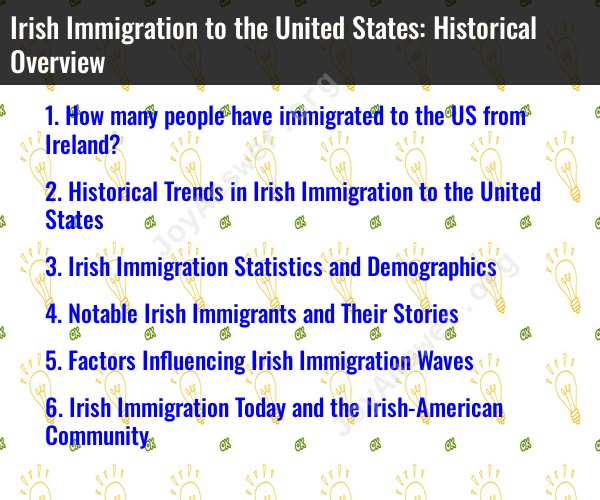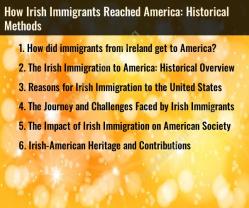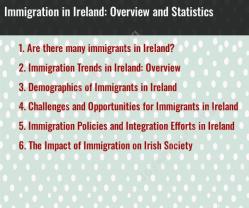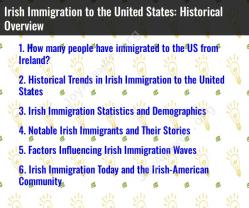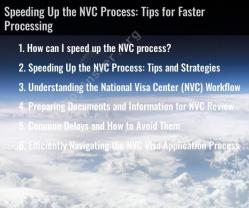How many people have immigrated to the US from Ireland?
Irish immigration to the United States has a long and significant history. While I can't provide an exact current number of Irish immigrants in the U.S., I can offer an overview of the historical patterns of Irish immigration to the United States.
Early Immigration (17th-18th centuries): The earliest Irish immigrants to the American colonies arrived during the 17th and 18th centuries. Many of these immigrants were of Scotch-Irish descent and settled in places like Pennsylvania, Virginia, and the Carolinas.
Great Famine (1845-1852): The most substantial wave of Irish immigration occurred during and after the Great Famine in Ireland (1845-1852). A devastating potato blight led to widespread famine and death in Ireland, prompting approximately 1.5 million Irish people to immigrate to the United States. This period is often referred to as the "Great Irish Potato Famine."
Late 19th and Early 20th Centuries: Irish immigration continued in the late 19th and early 20th centuries, with many Irish immigrants settling in cities like Boston, New York, and Chicago. They played a significant role in shaping American culture, particularly in the fields of politics, labor, and the arts.
Overall Numbers: Over the course of American history, millions of Irish immigrants and their descendants have come to the United States. It's estimated that, as of the 2020 U.S. Census, approximately 32 million Americans identified as having Irish ancestry.
Modern Immigration: While the major waves of Irish immigration occurred in the 19th century, there has been a continued but smaller flow of Irish immigrants to the United States in recent decades, often for economic or educational reasons.
It's important to note that these numbers are based on historical records and estimates. Irish immigration has had a profound impact on American society, culture, and politics, and the Irish American community remains a significant and influential ethnic group in the United States.
Historical Trends in Irish Immigration to the United States
Irish immigration to the United States has been a significant and enduring phenomenon, shaping the social, cultural, and economic landscape of both nations. The history of Irish immigration can be broadly divided into three major waves:
Early Period (1820-1860): This period saw the largest influx of Irish immigrants, driven by economic hardships, religious persecution, and the devastating Potato Famine. Over 2 million Irish people arrived in the United States during this time, seeking a better life and a chance to escape the harsh conditions of their homeland.
Later Period (1860-1920): This period was marked by a steady but smaller flow of Irish immigrants. While economic and political factors continued to play a role, family reunification and the growing Irish-American community in the United States became significant pull factors.
Post-World War II Era (1945-Present): Irish immigration in this period has been characterized by smaller numbers and a more diverse range of motivations. Economic opportunities, family ties, and cultural attractions have continued to draw Irish people to the United States.
Irish Immigration Statistics and Demographics
Irish immigration has had a profound impact on the demographics of the United States. According to the 2020 census, over 33 million Americans claim Irish ancestry, making it the second-largest ancestry group in the country. Irish immigrants have settled in various regions, with significant concentrations in cities like New York, Boston, Chicago, and Philadelphia.
Notable Irish Immigrants and Their Stories
Numerous Irish immigrants have made significant contributions to American society in various fields, including:
Politics: Andrew Jackson, John F. Kennedy, and many other Irish-American politicians have served in high-ranking positions, shaping American politics and governance.
Arts and Literature: Irish-American writers like Oscar Wilde, George Bernard Shaw, and Edna O'Brien have enriched American literature with their unique perspectives and storytelling.
Music and Entertainment: Irish-American musicians like Bing Crosby, John Travolta, and Bruce Springsteen have made significant contributions to American music and entertainment.
Science and Technology: Irish-American scientists like John Tyndall, John Philip Holland, and George Boole have made groundbreaking advancements in science and technology.
Factors Influencing Irish Immigration Waves
Several factors have influenced the waves of Irish immigration to the United States:
Economic Hardships: Economic downturns, land reforms, and agricultural crises in Ireland motivated many to seek better opportunities in the United States.
Religious Persecution: Discrimination and oppression against Catholics in Ireland drove many to seek religious freedom and tolerance in the United States.
Political Unrest: Political instability, rebellions, and lack of self-governance in Ireland encouraged some to seek political stability and participation in the United States.
Pull Factors: The promise of land ownership, employment opportunities, and a better life in the United States attracted many Irish immigrants.
Irish Immigration Today and the Irish-American Community
Irish immigration to the United States continues in smaller numbers but remains significant. The Irish-American community remains vibrant and influential, preserving their cultural heritage while contributing to the fabric of American society. Irish cultural events, organizations, and traditions continue to thrive, fostering a sense of identity and connection among Irish-Americans.
